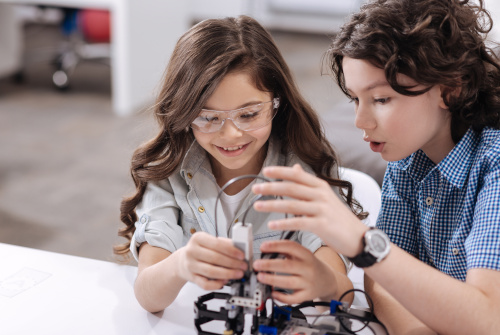Engineering is a critical part of STEM education, and engineers play a role in creating, improving, and maintaining some of today’s most valued and essential things, from smartphones and airplanes to zippers and roller coasters.
This year, Engineers Week celebrates “Creating the Future,” and it emphasizes the vital role engineers play in creating innovative solutions to some of the world’s most pressing problems and biggest challenges. Highlighting engineering also encourages students to pursue engineering classes and, potentially, engineering career paths.
When students become interested in STEM at a young age, their critical thinking, collaboration, creativity, and communication skills have a chance to thrive. Sustaining that interest is important, too, particularly because girls and underrepresented minority groups quickly lose interest in STEM learning–and never regain motivation to pursue it.
Because STEM is not a standalone, core academic subject, it’s implemented differently all over the country. Ultimately, through STEM learning, students should have the opportunity authentically apply their learning to solve real-world problems.
STEM is often introduced in middle and high schools, but by that time, many students have already avoided it, said Jason McKenna, director of Global Educational Strategy at VEX Robotics and author of What STEM Can Do for Your Classroom: Improving Student Problem Solving, Collaboration, and Engagement, Grades K–6.
Early STEM exposure–and successes or failures in STEM learning–can often make or break a child’s willingness to participate in STEM learning. Educational robotics can turn this downward trend around by incorporating all aspects of STEM in an engaging way that helps students reach success in problem-based learning challenges early on. This motivates students to tackle more difficult challenges.
“Students as young as 6 and 7 form an opinion about their proficiency in STEM subjects, and once that opinion is formed, it becomes very difficult to change,” he said. “Our job is to arm teachers with tools so they can introduce young students to authentic, engaging, fun activities. Now students can see themselves as someone in a STEM field–now they have the capability to do one of these STEM subjects.”
Educational robotics bridges the gap between rigid lessons and lessons that are too unstructured to motivate students, McKenna said. VEX Robotics leans heavily into the idea of guided problem solving–the idea that students have enough structure to understand their challenge or task, but enough space to explore different solutions.
Teachers ensure students have the background knowledge to begin the challenge and they set expectations for what success looks like. As students move through a challenge and the problem-solving process, teachers take away some scaffolding that was in place in earlier stages. Students can achieve their goal in different ways, trying different approaches and processes.
“You want a level of guidance and structure, and as students progress, you slowly take that scaffolding away and allow students to apply creative solutions to the problem,” he said.
This type of STEM exploration helps students realize that they can be STEM students.
“There’s no such thing as a math brain or a reading brain. We can become good at anything if we put enough time towards it,” McKenna said.
Related:
How computer science education bridges the digital divide
- 4 ways to support work-based learning - April 23, 2024
- Prioritizing inclusivity in game-based learning - April 22, 2024
- Friday 5: Universal Design for Learning - April 19, 2024

